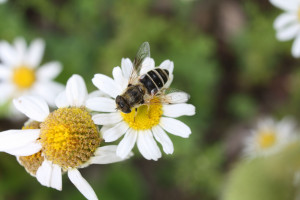 With nearly 900 species found across North America, syrphid flies (also called hover or flower flies) are a very important group of insects. The adults are frequently found hovering around flowers on bright, sunny days. Syrphid flies are significant pollinators, consuming nectar, pollen, and honeydew. As with all true flies, they have one pair of wings and, although at first glance some species may look superficially like small bees or wasps, their wing count is an easy way to separate the two (both bees and wasps have two pairs of wings). Syrphid flies can hover in mid-flight—hence their other common name of hover fly. They are often brightly colored with stripes or other markings. Many species mimic bees in their coloration with various patterns of black and yellow, white and black, and occasionally grey or brown. Adults measure between 0.16–1 in. (4–25 mm) with the majority of species falling somewhere in the middle and only a few at the extremes.
With nearly 900 species found across North America, syrphid flies (also called hover or flower flies) are a very important group of insects. The adults are frequently found hovering around flowers on bright, sunny days. Syrphid flies are significant pollinators, consuming nectar, pollen, and honeydew. As with all true flies, they have one pair of wings and, although at first glance some species may look superficially like small bees or wasps, their wing count is an easy way to separate the two (both bees and wasps have two pairs of wings). Syrphid flies can hover in mid-flight—hence their other common name of hover fly. They are often brightly colored with stripes or other markings. Many species mimic bees in their coloration with various patterns of black and yellow, white and black, and occasionally grey or brown. Adults measure between 0.16–1 in. (4–25 mm) with the majority of species falling somewhere in the middle and only a few at the extremes.
While the adults feed on flower products, their larvae are busy chowing down on various soft-bodied insects, including aphids, thrips, leafhoppers, scales, caterpillars and others. Members of the subfamily Syrphinae all have predaceous larvae (called maggots—they are flies after all) that are legless and measure between 0.04–0.5 in. (1–13 mm) in length. They taper to a point at the head end and range in color from green to creamy white or brown. Each maggot can consume several hundred insects during its three larval instars (life stages between molts) by nabbing the victim with its jaws and sucking it dry. Pupation lasts between one and two weeks or, at season’s end, continues through the winter. Many overlapping generations occur each season.
Adult syrphid fly mouthparts are sponge-like and are used to “seep” up plant nectar and pollen, both of which are consumed in ample amounts before reproduction and egg laying can occur. Females of several species are known to determine whether or not to lay eggs based on how many aphids are present in a colony. The number of eggs she lays is determined by her perception of a pest colony as “fit” to sustain her young. She can turn her reproductive capabilities on or off depending on semiochemical signals from both the infested plant and the aphids present on it.
Syrphid flies are incapable of stinging or biting and are a welcome sight in the garden. One study found them to be significantly better at locating aphids on collard greens than both ladybugs and green lacewings, though they will not fly on windy, rainy or cold days. Since adult syrphid flies are completely dependent on pollen and nectar for survival, having plenty of flowering plants around is a must. It’s been revealed in several studies that the number of syrphid fly species present in a field is significantly impacted by the diversity and abundance of flowers located nearby.







